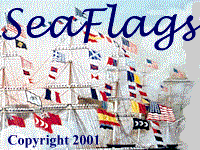
 |
U.S. Navy Command Pennants and Flags |
On this page:
Beginning with the 1858 Signals for the Use of the United States Navy, the Navy created a series so-called "triangular flags," or pennants, to designate the commanders of squadrons or divisions who were not of flag rank. These flags were the precursors of an elaborate series of such command pennants used during and after the Civil War and ultimately of today's broad and burgee command pennants, which were adopted.
The broad command
pennant is flown in lieu of the commission pennant by commanders of squadrons
of ships or aircraft wings who are not flag officers. It is shaped
like the now-obsolete commodore's broad pennant--indeed, the unit commanders
who use it are entitled to be addressed by courtesy as "commodore."
The broad command pennant is used in all respects the same as an admiral's
flag. It is broken aboard the commodore's flagship at the same points
of hoist as an admiral's flag, carried at the bow of a boat in which he or she
is embarked, emblazoned on social letterhead, displayed on a staff
in the commodore's office, and, if he or she should die in command, halfmasted aboard the
flagship and carried before the casket in the funeral ceremony. The
pennant is white with blue borders along the upper and lower edges and
the number of the unit in blue numerals on the center. The pennant
shown is that of the famous Destroyer Squadron 23, the "Little Beavers"
commanded by Captain (later Admiral) Arleigh Burke in the Pacific in World
War II.
The burgee command
pennant is used the same as the broad pennant, but by commanders of divisions
of ships or other craft or major subdivisions of aircraft wings. Under the current organization
of naval aviation, squadrons seem to be regarded as major subdivisions qualifying their commanding
officers to fly this flag, but this would not appear to be consistent with the intent of the
regulation, as Navy Regulations clearly differentiate between commanding officers of ships, squadrons, and
other basic units and commanders of higher echelon organizations. The illustration
shown represents Destroyer Division 231, one of the divisions under DesRon
23 in World War II.
Whenever two or more ships
are in the same port, the ship on which
the senior officer is embarked flies the senior officer present afloat
pennant, unless he or she is flying a personal flag clearly indicating
his or her seniority. The pennant is displayed from the inboard halyard
of the starboard main yardarm, but only while in port. (NavRegs
1280) For many years, the U.S. Navy's SOPA pennant was a plain blue
triangle (now the "subdivision"
signal pennant), but with the establishment of standard signal procedures
for the North Atlantic Treaty Organization, it was replaced in about 1950
by the "starboard" signal pennant, a long tapering pennant with a blunt
end composed of vertical green, white, and green stripes. The same
pennant is used for this purpose by the Royal Navy and, when conducting
NATO operations, by the French Marine Nationale and other NATO navies as
well.
A convoy commodore is a retired naval
officer or the most senior master of the merchant ships forming a convoy, with responsibility for its
internal organization and maneuvering. The commodore's
flag is flown from the flagship while forming or reforming
the convoy or whenever the commodore deems it necessary.
Sea
Flags
Copyright 2000, 2001 by Joseph McMillan